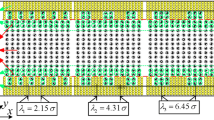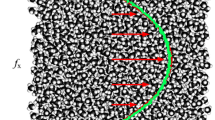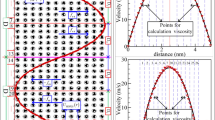Abstract
This paper presents a non-equilibrium multiscale molecular dynamics simulation method to investigate the effects of periodic wall surface roughness on the structure and mass transfer of methane fluid through the silicon nano-channels. In order to accurately capture the trajectories and microstructure of methane nano-fluidics, the present modification of OPLS fully atomic model is employed. Meanwhile, we introduce the corresponding coarse-grained model to solve the problem of wall–fluid interaction for methane Poiseuille flow within silicon atomic walls using the classical Lorentz–Berthelot mixing rules. The geometries of the upper wall roughness are modeled by rectangular waves with different amplitudes and wavelengths. The three-dimensional number densities of C (H) atom and kinetic energy distribution plots give a clear observation of the impacts of surface roughness on the localization micro-information of methane fluid. Moreover, the slip length of fluid over rough surface decreases with the increase in amplitude. The diffusion coefficients appear anisotropic, and the radial distribution functions decrease with the increase in the amplitude. These properties should be taken into account in the design of energy-saving emission reduction nano-fluidic devices. All numerical results also indicate that the presented method not only can well solve the issue of wall–fluid interactions, but also could accurately predict the micro-information and dynamic properties of methane Poiseuille flow.














Similar content being viewed by others
References
Allen MP, Tildesley DJ (1989) Computer simulation of liquids. Oxford University Press, Oxford
Asproulis N, Drikakis D (2011) Wall-mass effects on hydrodynamic boundary slip. Phys Rev E 84:031504
Asproulis N, Kalweit M, Drikakis D (2012) A hybrid molecular continuum method using point wise coupling. Adv Eng Softw 46:85–92
Bernardo P, Drioli E, Golemme G (2009) Membrane gas separation: a review/state of the art. Ind Eng Chem Res 48:4638–4663
Bhadauria R, Aluru N (2013) A quasi-continuum hydrodynamic model for slit shaped nanochannel flow. J Chem Phys 139:074109
Bhatia SK, Nicholson D (2011) Modeling self-diffusion of simple fluids in nanopores. J Phys Chem B 115:11700–11711
Bhushan B (2000) Mechanics and reliability of flexible magnetic media. Springer, Berlin
Bhushan B, Israelachvili JN, Landman U (1995) Nanotribology: friction, wear and lubrication at the atomic scale. Nature 374:607–616
Bitsanis I, Magda J, Tirrell M, Davis H (1987) Molecular dynamics of flow in micropores. J Chem Phys 87:1733–1750
Cao B-Y, Chen M, Guo Z-Y (2006a) Effect of surface roughness on gas flow in microchannels by molecular dynamics simulation. Int J Eng Sci 44:927–937
Cao B-Y, Chen M, Guo Z-Y (2006b) Liquid flow in surface-nanostructured channels studied by molecular dynamics simulation. Phys Rev E 74:066311
Cao B-Y, Sun J, Chen M, Guo Z-Y (2009) Molecular momentum transport at fluid-solid interfaces in MEMS/NEMS: a review. Int J Mol Sci 10:4638–4706
Choi WY, Osabe T, Liu T-JK (2008) Nano-electro-mechanical nonvolatile memory (NEMory) cell design and scaling. IEEE Trans Electron Dev 55:3482–3488
Corry B (2008) Designing carbon nanotube membranes for efficient water desalination. J Phys Chem B 112:1427–1434
Delhommelle J, Evans DJ (2001a) Configurational temperature profile in confined fluids. I. Atomic fluid. J Chem Phys 114:6229–6235
Delhommelle J, Evans DJ (2001b) Configurational temperature profile in confined fluids. II. Molecular fluids. J Chem Phys 114:6236–6241
DelRio FW, de Boer MP, Knapp JA, Reedy ED, Clews PJ, Dunn ML (2005) The role of van der Waals forces in adhesion of micromachined surfaces. Nat Mater 4:629–634
Diestler D, Schoen M, Hertzner AW, Cushman JH (1991) Fluids in micropores. III. Self-diffusion in a slit-pore with rough hard walls. J. Chem. Phys. 95:5432–5436
Frenkel D, Smit B (2001) Understanding molecular simulation: from algorithms to applications. Academic press, Cambridge
Galea T-M, Attard P (2004) Molecular dynamics study of the effect of atomic roughness on the slip length at the fluid-solid boundary during shear flow. Langmuir 20:3477–3482
Gargiuli J, Shapiro E, Gulhane H, Nair G, Drikakis D, Vadgama P (2006) Microfluidic systems for in situ formation of nylon 6, 6 membranes. J Membr Sci 282:257–265
Giannakopoulos AE, Sofos F, Karakasidis TE, Liakopoulos A (2014) A quasi-continuum multi-scale theory for self-diffusion and fluid ordering in nanochannel flows. Microfluid Nanofluid 17:1011–1023
Granick S (1991) Motions and relaxations of confined liquids. Science 253:1374–1379
Hansen J-P, McDonald IR (1990) Theory of simple liquids. Elsevier, New York
Hartkamp R, Ghosh A, Weinhart T, Luding S (2012) A study of the anisotropy of stress in a fluid confined in a nanochannel. J Chem Phys 137:044711
Hu C, Bai M, Lv J, Kou Z, Li X (2015) Molecular dynamics simulation on the tribology properties of two hard nanoparticles (diamond and silicon dioxide) confined by two iron blocks. Tribol Int 90:297–305
Jabbarzadeh A, Atkinson J, Tanner R (2000) Effect of the wall roughness on slip and rheological properties of hexadecane in molecular dynamics simulation of Couette shear flow between two sinusoidal walls. Phys Rev E 61:690
Jiang C, Ouyang J, Liu Q, Li W, Zhuang X (2016a) Studying the viscosity of methane fluid for different resolution levels models using Poiseuille flow in a nano-channel. Microfluid Nanofluid 20:157
Jiang C, Ouyang J, Zhuang X, Wang L, Li W (2016b) An efficient fully atomistic potential model for dense fluid methane. J Mol Struct 1117:192–200
Jorgensen WL, Tirado-Rives J (1988) The OPLS [optimized potentials for liquid simulations] potential functions for proteins, energy minimizations for crystals of cyclic peptides and crambin. J Am Chem Soc 110:1657–1666
Kamal C, Chakrabarti A, Banerjee A, Deb S (2013) Silicene beyond mono-layers—different stacking configurations and their properties. J Phys Condens Mat 25:085508
Karniadakis GE, Beskok A, Aluru N (2006) Microflows and nanoflows: fundamentals and simulation. Springer, Berlin
Kasiteropoulou D, Karakasidis T, Liakopoulos A (2012) A dissipative particle dynamics study of flow in periodically grooved nanochannels. Int J Numer Meth Fluids 68:1156–1172
Kim D, Darve E (2006) Molecular dynamics simulation of electro-osmotic flows in rough wall nanochannels. Phys Rev E 73:051203
Kim H, Strachan A (2015) Effect of surface roughness and size of beam on squeeze-film damping-Molecular dynamics simulation study. J Appl Phys 118:204304
Kong CL (1973) Combining rules for intermolecular potential parameters. II. Rules for the Lennard-Jones (12-6) potential and the Morse potential. J Chem Phys 59:2464–2467
Kumar G, Smith S, Jaiswal R, Beaudoin S (2008) Scaling of van der Waals and electrostatic adhesion interactions from the micro-to the nano-scale. J Adhes Sci Technol 22:407–428
Kumar V, Sridhar S, Errington JR (2011) Monte Carlo simulation strategies for computing the wetting properties of fluids at geometrically rough surfaces. J Chem Phys 135:184702
Liakopoulos A, Sofos F, Karakasidis TE (2016) Friction factor in nanochannel flows. Microfluid Nanofluid 20:24
Liem SY, Brown D, Clarke JH (1992) Investigation of the homogeneous-shear nonequilibrium-molecular-dynamics method. Phys Rev A 45:3706
Malijevský A (2014) Does surface roughness amplify wetting? J Chem Phys 141:184703
Mantzalis D, Asproulis N, Drikakis D (2011) Filtering carbon dioxide through carbon nanotubes. Chem Phys Lett 506:81–85
Markesteijn A, Hartkamp R, Luding S, Westerweel J (2012) A comparison of the value of viscosity for several water models using Poiseuille flow in a nano-channel. J Chem Phys 136:134104
Mashayak S, Aluru N (2012a) Coarse-grained potential model for structural prediction of confined water. J Chem Theory Comput 8:1828–1840
Mashayak S, Aluru N (2012b) Thermodynamic state-dependent structure-based coarse-graining of confined water. J Chem Phys 137:214707
Menezes PL, Ingole SP, Nosonovsky M, Kailas SV, Lovell MR (2013) Tribology for scientists and engineers. Springer, Berlin
Mo G, Rosenberger F (1990) Molecular-dynamics simulation of flow in a two-dimensional channel with atomically rough walls. Phys Rev A 42:4688
Noid W (2013) Perspective: coarse-grained models for biomolecular systems. J Chem Phys 139:090901
Noorian H, Toghraie D, Azimian A (2014) The effects of surface roughness geometry of flow undergoing Poiseuille flow by molecular dynamics simulation. Heat Mass Transfer 50:95–104
Poling BE, Prausnitz JM, John Paul OC, Reid RC (2001) The properties of gases and liquids. McGraw-Hill, New York
Priezjev NV (2007) Effect of surface roughness on rate-dependent slip in simple fluids. J Chem Phys 127:144708
Priezjev NV, Darhuber AA, Troian SM (2005) Slip behavior in liquid films on surfaces of patterned wettability: comparison between continuum and molecular dynamics simulations. Phys Rev E 71:041608
Ranjith SK, Patnaik B, Vedantam S (2013) No-slip boundary condition in finite-size dissipative particle dynamics. J Comput Phys 232:174–188
Rapaport DC (2004) The art of molecular dynamics simulation. Cambridge University Press, Cambridge
Sadus RJ (2002) Molecular simulation of fluids. Elsevier, Netherlands
Sbragaglia M, Benzi R, Biferale L, Succi S, Toschi F (2006) Surface roughness-hydrophobicity coupling in microchannel and nanochannel flows. Phys Rev Lett 97:204503
Schiermeier Q (2006) Methane finding baffles scientists. Nature 439:128
Shell MS (2008) The relative entropy is fundamental to multiscale and inverse thermodynamic problems. J Chem Phys 129:108
Sofos F, Karakasidis T, Liakopoulos A (2009a) Transport properties of liquid argon in krypton nanochannels: anisotropy and non-homogeneity introduced by the solid walls. Int J Heat Mass Transf 52:735–743
Sofos F, Karakasidis T, Liakopoulos A (2009b) Variation of transport properties along nanochannels: a study by non-equilibrium molecular dynamics. In: IUTAM symposium on advances in micro-and nanofluidics. Springer, pp 67–78
Sofos FD, Karakasidis TE, Liakopoulos A (2009c) Effects of wall roughness on flow in nanochannels. Phys Rev E 79:026305
Sofos F, Karakasidis TE, Liakopoulos A (2010) Effect of wall roughness on shear viscosity and diffusion in nanochannels. Int J Heat Mass Transf 53:3839–3846
Sofos F, Karakasidis TE, Liakopoulos A (2012) Surface wettability effects on flow in rough wall nanochannels. Microfluid Nanofluid 12:25–31
Sofos F, Karakasidis TE, Giannakopoulos AE, Liakopoulos A (2016) Molecular dynamics simulation on flows in nano-ribbed and nano-grooved channels. Heat Mass Transf 52:153–162
Sparreboom W, Van Den Berg A, Eijkel J (2010) Transport in nanofluidic systems: a review of theory and applications. New J Phys 12:015004
Svoboda M, Malijevský A, Lísal M (2015) Wetting properties of molecularly rough surfaces. J Chem Phys 143:104701
Wang J, Chen D, Pui D (2007) Modeling of filtration efficiency of nanoparticles in standard filter media. J Nanopart Res 9:109–115
Zhang Y (2016a) Effect of wall surface modification in the combined Couette and Poiseuille flows in a nano channel. Int J Heat Mass Transf 100:672–679
Zhang Y (2016b) Effect of wall surface roughness on mass transfer in a nano channel. Int J Heat Mass Transf 100:295–302
Ziarani A, Mohamad A (2006) A molecular dynamics study of perturbed Poiseuille flow in a nanochannel. Microfluid Nanofluid 2:12–20
Acknowledgements
We are very grateful to the anonymous referees who have provided us with valuable comments and suggestions for improving our study. This work is financially supported by the National Basic Research Program of China (973 Program) (Grant No. 2012CB025903), the Major Research Plan of the National Natural Science Foundation of China (Grant No. 91434201) and the National Natural Science Foundation of China (Grant Nos. 11402210, 11671321).
Author information
Authors and Affiliations
Corresponding author
Rights and permissions
About this article
Cite this article
Jiang, C., Ouyang, J., Li, W. et al. The effects of wall roughness on the methane flow in nano-channels using non-equilibrium multiscale molecular dynamics simulation. Microfluid Nanofluid 21, 92 (2017). https://doi.org/10.1007/s10404-017-1927-2
Received:
Accepted:
Published:
DOI: https://doi.org/10.1007/s10404-017-1927-2




